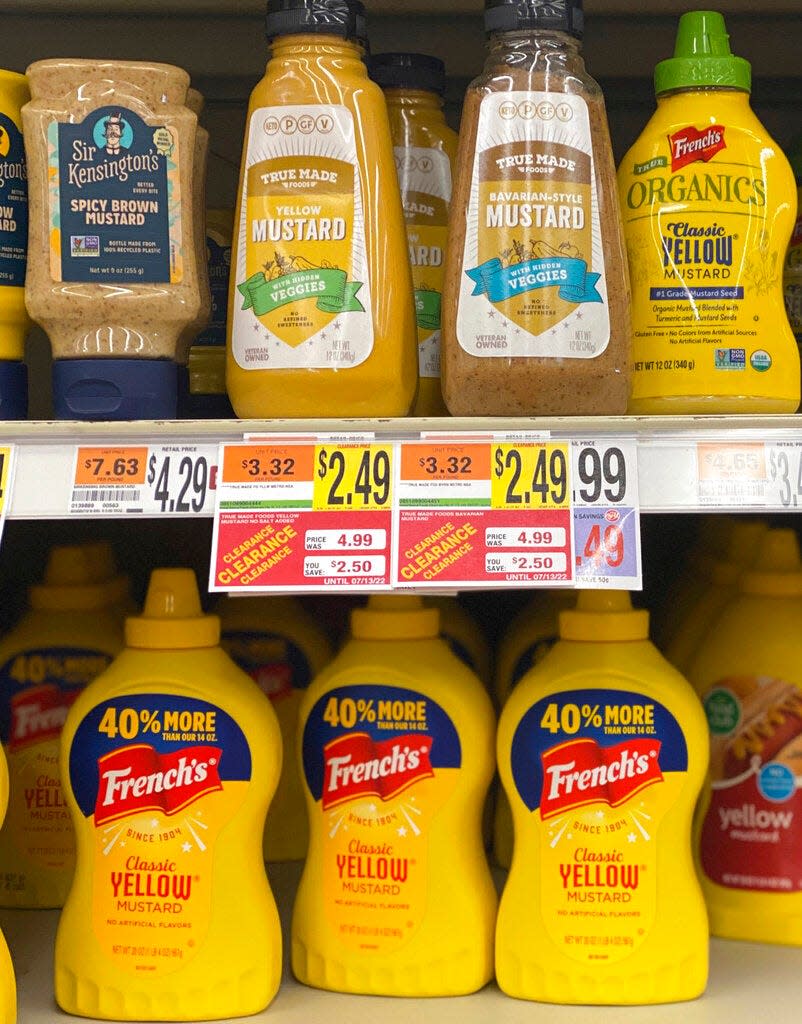Will you have to have to eat your July Fourth hot dog or hamburger without mustard?
The supply chain crisis just keeps topping itself (pun intended).
Remember last summer, when we were scrounging for Heinz ketchup packets to use on our takeout food? How about earlier this summer, when Huy Fong Inc., maker of Sriracha, warned consumers it doesn't have enough chili peppers to make its famous hot sauce until at least this fall?
Now comes news that Europe is experiencing a mustard shortage, and there's concern it might hit the U.S. as Americans descend on grocery stores to stock up for their Fourth of July cookouts.
What's behind the latest condiment crisis? Climate change and – to a lesser degree – the 4-month-old war in Ukraine are the biggest culprits.
So will we be blue because there's no yellow on our Fourth of July hot dogs and hamburgers? Read on to see whether the mustard shortage will be felt here.
KFC Finger Sporks: How to get new finger-friendly utensils
Stuffed: How to make Cheesecake Factory's stuffed cheddar burger at home
Why is there a mustard shortage?

"The simple answer is that the mustard shortage results from drought conditions realized across the majority of western Canada and northern U.S., which is the primary growing region for mustard seed," Allen Sass, president of Wisconsin Spice, tells USA TODAY in an email. He adds that in 2020, fewer acres were set aside for growing mustard, a trend that has carried forward.
Because there are fewer mustard plants yielding fewer seeds, production has dropped by as much as half and mustard producers are being forced to pay a premium for available seeds.
Kraft Mac and Cheese gets a makeover: Product changes name, packaging
Grill tips: 5 things to know for grilling the perfect, juicy burger on a propane grill
Where do we get our mustard seeds?
Canada is the world's top mustard exporter, supplying 75% of global imports and 90% of the seeds used in North American production, Sass says. The U.S. provides only about 10% of North American seed needs.
"The world depends on Canada's mustard seed, and given the aforementioned lack of supply relative to historical demand, the global marketplace is seeing the impact of this shortage," he says.
According to Tridge, a food and agriculture research firm, Germany and India also ranked among the top five global exporters as of 2020, along with two countries that happen to be at war with each other right now: Russia and Ukraine.
But Sass says the U.S. hasn't traditionally depended on mustard supply from either.
Forget 'Dry January': Alcohol-free beer, wine, cocktails are available year round and are gaining popularity
Be inconspicuous: Taking an alcohol break? Giving it up completely? Here's how to be inconspicuous
How is mustard made?
Mustard seeds are crushed into powder to release the elements that give the condiment its pungent taste and aroma, according to MadeHow.com.
That powder is combined with water, wine or vinegar at food processing plants. If it's being sold in the spice aisle, it's left in powdered form.
The color of the seeds being used varies depending on which form of mustard is being produced. For instance, the bright yellow mustard you find at most fast-food restaurants comes from yellow seeds, while Dijon uses brown and black. German mustard uses all three.
Is it affecting all kinds of mustard?
"Brown mustard seed – used in manufacturing Dijon and deli or spicy brown styles of mustard – has seen the greatest impact," Sass says. "But, given the ubiquitous and high consumption of yellow mustard seed, this type of mustard seed has seen the greatest deviation in supply relative to demand."
Will the U.S. feel the shortage?
France 24, a state-owned broadcaster, reports the shortage is already noticeable in that country, which is the birthplace of Dijon mustard and one of the countries most associated with the condiment. The U.K. is expected to feel it next. The question is whether it will spread to the U.S.
Kraft Heinz, which owns Grey Poupon, and McCormick, which makes French's mustard, don't foresee empty shelves in U.S. grocery stores.
"As soon as our Grey Poupon team identified a potential supply issue, we immediately worked to identify other sources of brown mustard seed in different parts of the world," Kraft Heinz said in a statement to USA TODAY.
Likewise, McCormick says it was able to see the problem coming and act proactively. “McCormick & Company is not experiencing shortages of mustard seed which we attribute to our resilient global supply chain and strong sourcing capabilities," it told USA TODAY via email. "French’s Mustard will be on store shelves for consumers to enjoy.”
How long is the shortage expected to last?
Not long. Thankfully, Sass says, "the next harvest is around the corner – August in the U.S. and September in Canada. So far, growing conditions have generated optimism toward a more average yield. Further, acres allocated to mustard seed in Canada and the U.S. have increased sharply in 2022."
But he cautions that "even though harvest is just a few months away, there is a long way to go in terms of weather obstacles."
But absent major weather catastrophes, Sass says, "overall, we’re optimistic that supply coming out of the 2022 harvest will cover demand, but mustard markets are expected to remain tight in the year ahead."
Not the Sriracha! Hot sauce in short supply due to chili pepper shortage
This article originally appeared on USA TODAY: Mustard shortage: Why is it happening? Will it hit US? What to know

 Yahoo Movies
Yahoo Movies 
